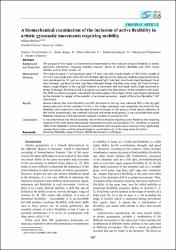A biomechanical examination of the inclusion of active flexibility in artistic gymnastic movements requiring mobility
Özet
Background
and Study Aim
The purpose of the study is a biomechanical examination of the inclusion of active flexibility in artistic
gymnastic movements requiring mobility (muscles' ability to stretch), flexibility and other motor
abilities such as force, power, etc.
Material and
Methods
The study included 17 girl gymnasts aged 7-9 years old, with a body height of 140.7±10.2, weight of
34.1±6.4, and a body mass index of 17.6±3.0. Data collection in the study was made by using performance
tests developed by FIG such as a Forward-Backward Split, Side Spit, Arm-Trunk Angle Backward, Trunk
Bent Forward, Leg Raise forward, Leg Raise Sideward, Bridge, Standing long Jump, Lift Trunk Forward60secs, Angle Degree of the Leg Split Position in Cartwheel, and Arm-Upper Body Angle Backward in
Bridge Technique. The Kinovea 0.8.15 program was used in the data analysis of the variables in the study.
The SPSS 24 software program was used for the data analysis. Percentages of the angle degree calculated
by the formula “%= (angle0
of the mobility in functional movement / angle0
of the active flexibility) *100”
were found.
Results Results indicate that active flexibility was 90% functional in the leg raise sideward, 90% in the leg split
during execution of the cartwheel, 17.5% in the bridge technique, and completely functional for the
flexibility ratio expressed in the leg raise forward technique. In the analysis of the various elements of
the similar biomechanics, the anatomic structure and similar body planes, it was concluded that active
flexibility expressed in the movements required a mobility of around 65-75%.
Conclusions: It was determined that the functionality rate of the techniques requiring active flexibility and requiring
mobility of the same biomechanical and anatomical structure was around 65-75%. Therefore, to execute
100% of the flexibility in action (during active elements) as it is in a passively or actively, it may significantly
increase force, motor control, dynamic balance, coordination etc., in the large range of motion.
Cilt
25Sayı
5Bağlantı
https://hdl.handle.net/11363/4654Koleksiyonlar
Aşağıdaki lisans dosyası bu öğe ile ilişkilidir:


















